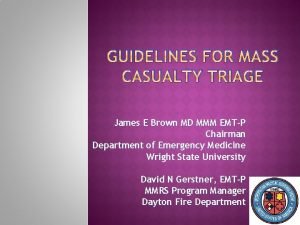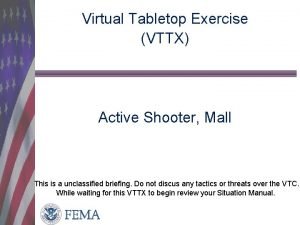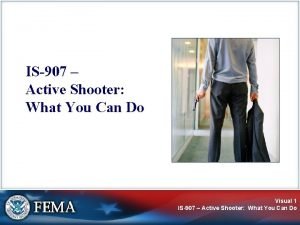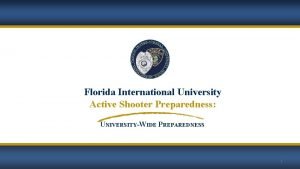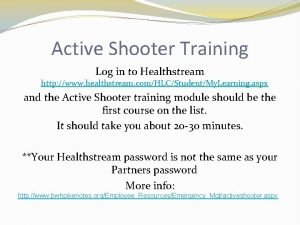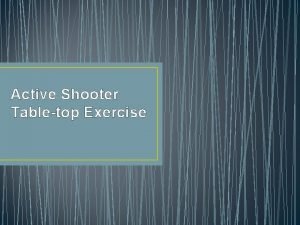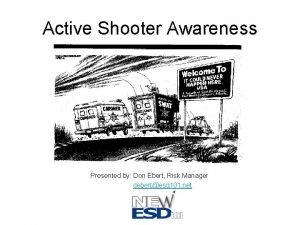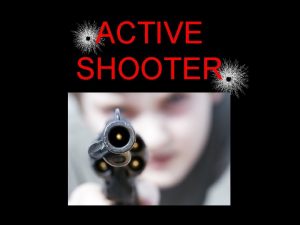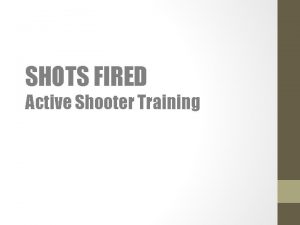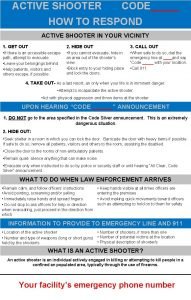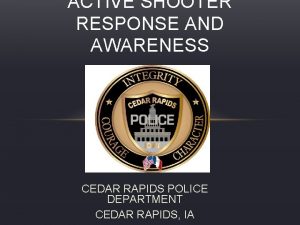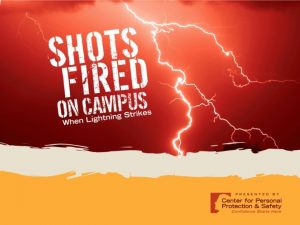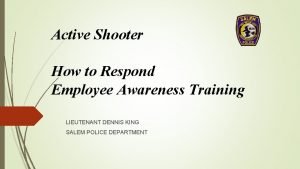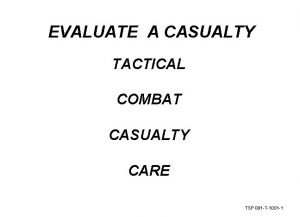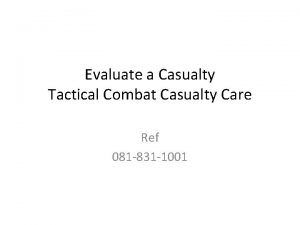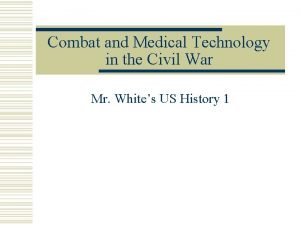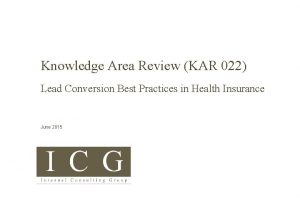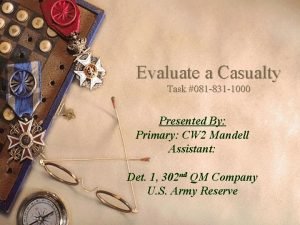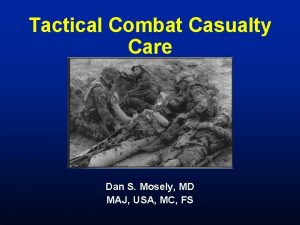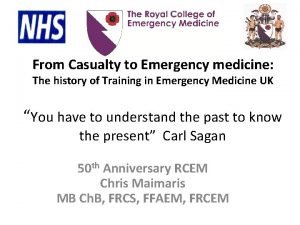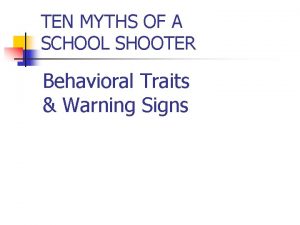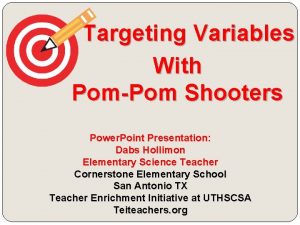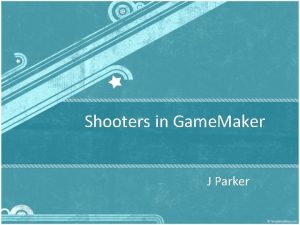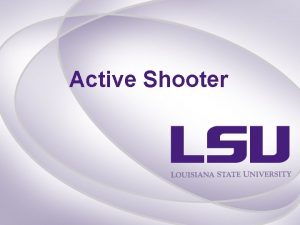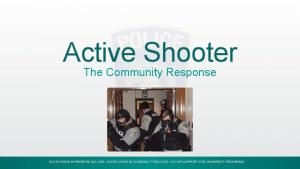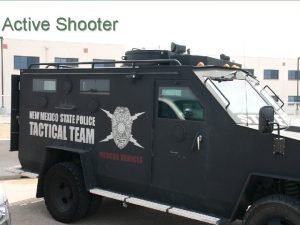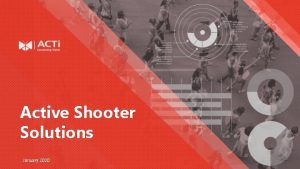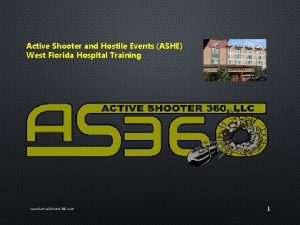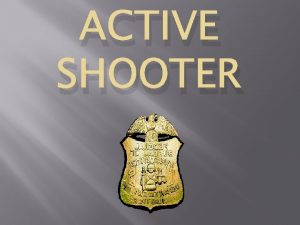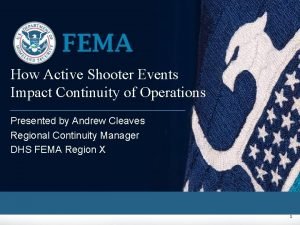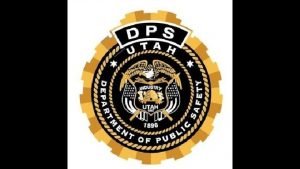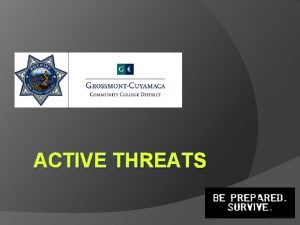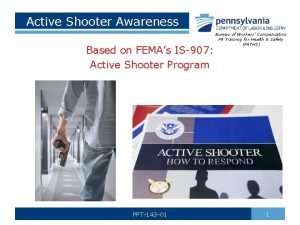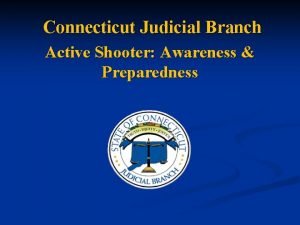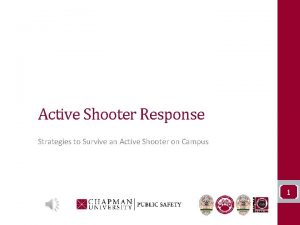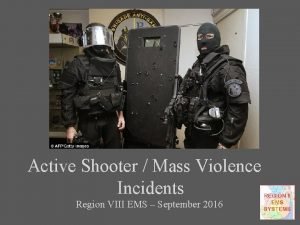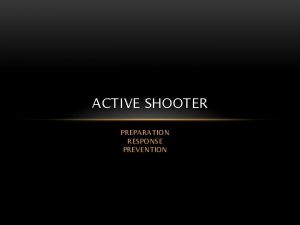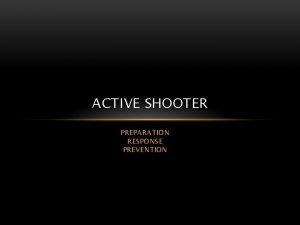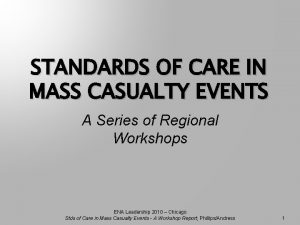Active Shooter and Mass Casualty Events Planning Prevention






























- Slides: 30

Active Shooter and Mass Casualty Events: Planning, Prevention, Mitigation and Survival Special Agent in Charge Christopher Combs San Antonio FBI 1

Teaching Points � Define active shooter � Analyze statistical data related to active shooter events � Provide a brief history of active shooter events � Discuss planning for an active shooter event � Explain what to do if involved in an active shooter event � Discuss working with first responders � Discuss medical considerations � Discuss organizational planning � Discuss pre-attack behavioral indicators 2

Active Shooter �The FBI defines an “active shooter as an individual actively engaged in killing, or attempting to kill people in a populated area. ” 3

FBI Active Shooter Study 5

Active Shooter Events 6

Active Shooter Events 7

Active Shooter Location Categories 8

Active Shooter Study – Trends in School AS Events � Most shooters : Males 12 -18 who acted alone Students or former students reported being “bullied” citing revenge as their motivation. planned their attacks in advance demonstrated concerning behaviors to others 9

Pre-Attack Indicators �Many shooters described as “social isolates, ” �Developed personal grievance �Significant real or perceived personal loss before attack �Few had previous arrests for violent crimes. 11

Pre-Attack Indicators �Behaviors may include: Contextually inappropriate recent ▪ acquisition of multiple weapons. ▪ escalation in target practice/weapons training. ▪ interest in explosives/Improvised Explosive Devices. ▪ intense interest/fascination with previous shootings/mass attacks. 12

Active Shooter Events �Do not have an “it will never happen here mindset. ” �Do have a plan. �Do develop the plan before the event Plan must be flexible. �Do practice the plan 14

What can you do? Run Hide Fight 15

Considerations �Situational Awareness Exits Ability to Hide Ability to Barricade Availability of Weapons (improvised or otherwise) 17

Run �Have an escape route/plan. �Leave belongings behind. �Get others to go with you, and don’t delay. �Be prepared for police response. �Be prepared to change route/plan if you encounter gunman. �Only call 911 when it is safe to do so. 18

Hide �Hide in an area out of the shooter’s view. �Block entry to your hiding place and lock the doors. �Silence your cell phone, etc. . . �Turn off lights. �Have a plan if found by the shooter or law enforcement. �What is your endgame? 19

Fight �As a last resort and only when your life is in imminent danger. �Attempt to incapacitate the shooter. �Act with physical aggression and throw items at the shooter. �Attack the weapon or the shooter’s ability to kill. �You must fight like your life depends on it; it does. 21

Police Action �First priority is to stop the killing. �Will move directly to the threat. �Will not render aid until the killing has stopped. 22

Information for Police �Location of shooter. �Number of shooters. �Physical description of shooters. �Number and type of weapons held by shooters. �Number of potential victims at the location and where are they located. 23

When Police Arrive � Remain calm and follow instructions. � Drop any items in your hands (i. e. bags, jackets). � Raise hands and spread fingers. � Keep hands visible at all times (free of cell phones which are commonly mistaken for weapons). � Avoid quick movements towards officers such as holding on to them for safety. 24

Medical �There won’t be enough emergency personnel to care for all of the wounded �Provide medical care as soon as possible �Stop The Bleed Equipment and Training 26

Organizational Planning �Have a plan �Be specific to your location and structure �Should be flexible �Train the plan �Plan must not be dependent on hierarchal structure 27

Organizational Planning � Multi-Layered warning system (Audio/Text) � Blueprints Where are they kept? � Closed Circuit Camera Systems Where can they be accessed from? � Utilities Is there a plan to turn them off if needed? � Continued Operations How will you maintain operations if denied access to your building for an extended period of time? 28

School Safety � 93% of school attacks were planned �Many offenders displayed pre-attack planning behaviors. �In 81% of planned incidents, others knew about the impending attack ahead of time. 29

Failure to Report �Fear of negative repercussions �Not believing the threat was real �Not knowing who to tell �Thinking someone already reported/knows �Thinking they had more time to decide what to do 30

Student Threat Reporting �Build trust and communicate with students �Provide reassurance that reporting is confidential and anonymous �Distinguish tattling/snitching from reporting a life threatening danger �Take all threats seriously, even when told in a joking manner 31

Student Threat Reporting �Don’t assume someone else has reported it. �Be aware of warning signs on social media postings �Consider creative/accessible reporting process (text messaging) and publicize the process 32

Threat Assessment Team �Multidisciplinary Team �Assess threats �Review all available information �Determine appropriate action �Develop action plan �Collaborate with community agencies �Communicate with parents/guardians �Removes stovepipes 34

Planning Guides 36

FBI Tools App for State and Local Law Enforcement on the FBI’s Incident Commander Pocket Guide 37

Questions? Find your local FBI Office: https: //www. fbi. gov/contact-us 38
 Primary prevention secondary prevention tertiary prevention
Primary prevention secondary prevention tertiary prevention Mass casualty triage guidelines
Mass casualty triage guidelines Virtual tabletop exercise
Virtual tabletop exercise Is907
Is907 Fiu active shooter training
Fiu active shooter training Run hide fight
Run hide fight Www.healthstream/hlc/rwjuh
Www.healthstream/hlc/rwjuh Active shooter tabletop
Active shooter tabletop Bath assessment active shooter
Bath assessment active shooter Define active shooter
Define active shooter Extreme response gap
Extreme response gap Active shooter code
Active shooter code Active shooter tabletop
Active shooter tabletop Cedar rapids active shooter
Cedar rapids active shooter A survival mindset is comprised of which three components
A survival mindset is comprised of which three components Active shooter healthstream
Active shooter healthstream Evaluate a casualty
Evaluate a casualty Combat casualty assessment
Combat casualty assessment How did the minie-ball affect the casualty rate of the war?
How did the minie-ball affect the casualty rate of the war? California casualty claims
California casualty claims 8 steps to evaluate a casualty army
8 steps to evaluate a casualty army Casualty assistance officer
Casualty assistance officer Tactical combat casualty care
Tactical combat casualty care How will you open the casualty's airway
How will you open the casualty's airway Pgmdt
Pgmdt Mutually exclusive events vs not mutually exclusive events
Mutually exclusive events vs not mutually exclusive events 3 to 8 decoder truth table
3 to 8 decoder truth table Primary vs secondary active transport
Primary vs secondary active transport School shooter traits
School shooter traits Pom pom shooter
Pom pom shooter Shooting game maker
Shooting game maker

